Hamoudi “Jagger” Baby has slit jugulars for 30 years. As he squats on a sand dune, waiting for the next job, he seems oblivious to the animated scrum behind the thorn tree. Ten metres away, a dozen teenagers are wrestling an animal to the ground.
The 45-year-old slaughterer wears a blood-splattered blue T-shirt. Everyone says he got his nickname because he dances like a Rolling Stone. His blade has been refashioned from sharpening. Its handle is impregnated with blood.
Someone calls “Jagger!”, and the crowd forms a human passageway to the kill. The camel’s hooves are tied together. The animal is silent; everyone is. Jagger ambles up, mumbles “Allahu Akbar” and delivers two strokes of the knife to its neck.
Blood pours from the twitching animal, settling like a crimson lake on the pale sand. Now Jagger has something to say. “We are not proud of killing a camel and this one was young. But there are not enough cattle at this time of year, because of the [lack of] rain. There used to be grazing all year round. Until the 1973 drought, there were even trees here,” he says, indicating the bald dunes encroaching on the northern city limits.
Timbuktu, city of gold, ancient centre of learning, is slowly turning to dust. The Sahara desert is stifling life, but residents know the blame lies not only with natural forces. Timbuktu is teetering on the edge of existence also because of human neglect, war and greed. Under-development and corruption are the co-conspirators of desertification. The city is not only garrisoned physically, it is mentally sanded in.
In an earlier, richer age, visitors approaching the city on camel-back after a month-long desert crossing were greeted by mango trees bearing golden fruit. A network of canals freshened the air. Manuscripts from the 16th century describe a magical peninsula where Arabs and Africans exchanged salt for gold. A combination of awe and wealth built fabulous mosques and intellectual vibrancy. In the 19th century, European explorers died trying to get here. Timbuktu became lodged in the collective imagination as a place so extraordinary that it might not exist at all.
These days, visitors arrive mostly from the south. Garrisoned in rebel territory ever since it was seized and occupied in 2012-13 by secessionists and Islamists linked to Al-Qaida, the city is a dangerous 600 mile drive north-east of Mali’s capital, Bamako. A Niger riverboat runs for the three navigable months of the year. Journalists are advised to travel with the United Nations on its daily flight into the city. No planes are open to the Malian public.
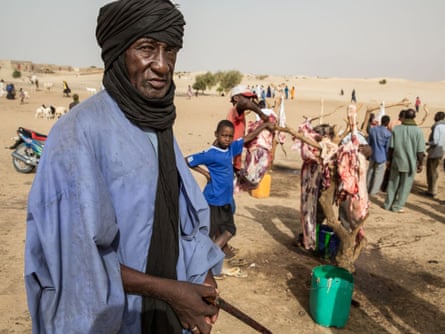
Timbuktu is a city of beige. The sand on the streets is only a shade paler than the banco clay that lines the walls. The monochrome palette is interrupted by splashes of pale green – from the tiny leaves of thorn trees – and blotches of sky blue, when the helmeted UN peacekeepers cruise past in their vehicles. There are 1,200 assigned for Timbuktu alone, for a population now estimated at less than 15,000.
Timbuktu’s appellation as a city feels dubious. Sean Smith, the Guardian’s photographer, is the only guest staying in the city’s La Colombe hotel. At night, even the manager goes home, leaving him all alone. Yet the history books say Timbuktu boasted 25,000 students in its heyday, having established one of the world’s earliest universities in the 12th century.
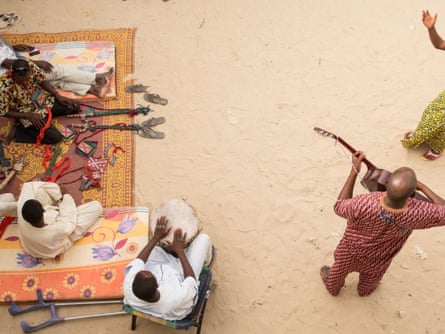
These days, the city is silent, as though the sand and dry heat (temperatures rise uncomfortably into the 40s through summer) jointly deaden sound. And it is slow: there are no traffic lights and hardly any cars. This is a city run on donkeys: public transport is limited to half a dozen ancient Land Rovers which trundle askew their wheelbases to and from the river Niger, a dozen miles to the south. The canal that takes its source there last provided year-round water in 1955.
People in Timbuktu either adapt or leave. As the canal dried up and the winds of rain increasingly brought dust, Mahamane Alphady’s father – “or it could have been my grandfather” – dug a hole. So did all the other market gardeners, creating dozens of craters that fed on the canal’s run-off water. Vegetables grew on their walls. But every year they had to dig deeper. In 1973, his father gave up.
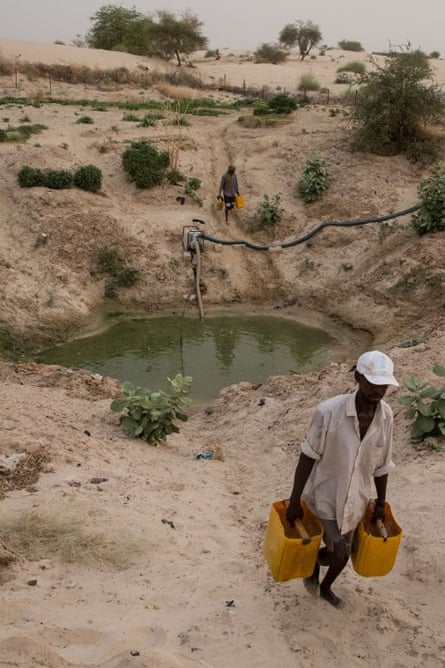
“He told me to get a job with the council,” says 51-year-old Mahamane. “I worked as a street cleaner. Ours was the last hole to function and we never thought it would see water again.”
Today, however, the Alphady pit on the western end of town has water in the bottom again. The fenced sunken garden is producing “groundnuts, potatoes, millet, water melons, mint, tomatoes – anything we want, really”. His wife sells the produce at the market and their nine children have healthy diets.
But the Alphadys’ good fortune is just a reprieve. Their pit is close to a hotel which was bought by the late Libyan leader, Muammar Gaddafi, 10 years ago. It lacked a water feature. So in 2006, Gaddafi sent earthmoving equipment and dug out the Timbuktu canal all the way to the Niger river. “Gaddafi brought the birds back to Timbuktu,” says Mahamane, glowing. “I was able to go back to the job I am supposed to do. I have been able to send my children to school, to give them a different life to look forward to.”
Local historian Salem Ould Elhadje, author of two books on Timbuktu, takes the gloss off the story, however. “Gaddafi brought water to the city for a year or so. But now – and for all but about three months of the year after the Niger floods – the canal is a sandy bowl with a succession of inoperative sluices. Other attempts to reverse the effects of desertification have also failed. Palisades and trees were planted around the airport in the 1990s. But during the crisis, they were chopped up for firewood.”
“The crisis” is what Malians call the March 2012 military coup that was followed by the takeover of the north of the country by rebels. Islamic fundamentalists enforced Sharia law and destroyed some of Timbuktu’s ancient mausoleums and manuscripts. In January 2013, former colonial power France intervened militarily. The UN followed with 10,000 soldiers and police. But a peace deal for northern Mali has yet to be signed.
Life in the desert
Haoussa Tandina does not want to talk to me about climate change. “It is God’s will,” she shrugs. “We are desert people who know how to adapt. We like the heat. Down south there is dampness and mosquitoes and disease.”
Haoussa, 35, is the breadwinner in her family. Her husband Oumar “Jex”, 50, lost his job as a hotel cleaner when the terrorists replaced the tourists. The couple have five children. Helped by 17-year-old Tata, Haoussa fills and knots pint-sized transparent bags from the household’s only tap. She is making ice. It is one of her many businesses. Selling fabric and clothes are others.
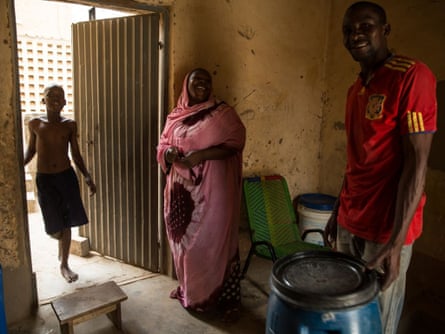
Right now, the city centre around her 14th-century two-up, two-down sandstone terraced house appears safe. But Haoussa says the rebels are still in town – dormant – and are active all around it; and that the checkpoints which block traffic in and out of the city between 6.30pm and 7am each night are insufficient.
On 30 June, when Haoussa last returned from Bamako with stock to sell, her bus was held up by bandits about halfway home. “It was around 8pm. There was machine-gun fire. They blocked the road with a truck: everyone out, on the ground, face down, hands on our backs. They took all my stock, my phone, some silver necklaces I had bought. The value was 190,000 [CFA] francs (£230).”
During the occupation – from April 2012 to January 2013 – Haoussa had fled south, joining an exodus of thousands from Timbuktu. “At first the occupiers did not seem so bad,” she recalls. “They brought law and order. They only cut off one man’s hand, for suspected stealing, and they got everyone to stop drinking and obey the one-way streets. It made a change. We are so tired of corruption and favouritism from the authorities.
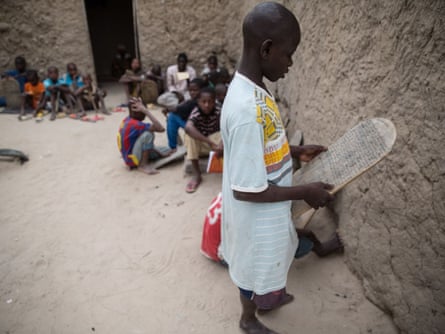
“Then, one day, one of them walked right in here with his weapon. He accused Tata of being improperly dressed. He tried to grab her, to take her to the prison where we knew they flogged girls and raped them. That night we left for Ségou. I ran up a lot of debts while we were away.”
Ice buyer Sidi Maiga, 19, comes to call. He goes from house to house on his motorbike, buying lumps of ice for 25 francs (three pence) each. Once fully laden, he rides south to the river and sells the bagged ice for 50 francs to fishermen and market women. On the Timbuktu scale of things – where a loaf of bread costs 150 francs – frozen tap water is a money-spinner. He rejects some of Haoussa’s bags as “not frozen enough”.
She blames the parastatal Eléctricité du Mali. “EDM tricked us. Timbuktu is the only place in Mali where they imposed pre-paid meters. Everywhere else it was voluntary. With the new system, they only gave us 5 amps each. Now our freezers are struggling, and they’ve put the price up.”
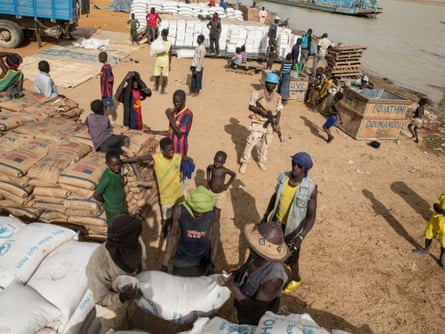
State institutions, the electricity board, the banks and the judiciary are all seen as extensions of a centralised state that has neglected Timbuktu ever since Mali’s independence in 1960. Such has been the lack of interest from the capital that no geological survey exists which might show the city’s groundwater prospects.
Reaching the river Niger demands a 30-minute slalom around 12 miles of potholes on the only stretch of tar in a region bigger than France. The road goes past the airport, which came under attack from three 122mm rockets only a few days earlier. But the traders who ply the route in wonky Land Rovers are not fazed: “They want to frighten the UN and the French. They want to cut off Timbuktu so they can keep control of the economy.”
“Who are ‘they’?” I ask.
“Arabs, Tuaregs, armed groups … maybe the MNLA [Mouvement National pour la Libération de l’Azawad], maybe one of the others like Ansar Dine or Aqim (Al-Qaida in the Islamic Maghreb). They work for the cartels. They disagree politically but when it comes to smuggling food, arms, humans and cocaine, all the groups work together.”
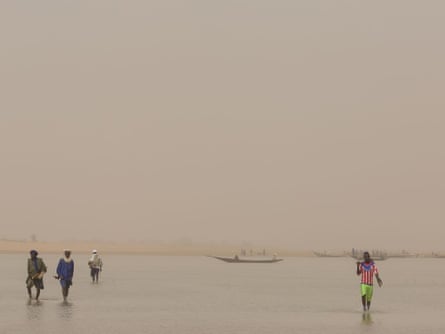
In fact, the Tuareg people have effectively been ethnically cleansed from Timbuktu and elsewhere in Mali. Around 130,000 are refugees in Niger, Burkina Faso and Mauritania, having been accused by Mali’s majority black population of collaborating with the secessionist MNLA. They fear torture, revenge killings and arrest by the Malian army. Dozens of cases have been documented, but the government in Bamako has done nothing to bring perpetrators to justice.
The road to the river plunges into a cool eucalyptus alley, planted a decade ago to slow desertification. Behind the lanky trees, rice fields are waiting to be flooded as soon as the Niger obliges. “The rice growers were happy when the jihadists were here. They gave away all the fertiliser and fuel that the civil servants had hoarded for their cronies.”
On the map, the riverside markets of Toya and Korioumé appear separate from Timbuktu. In fact, they have become integral to the city’s economy as the canal has dried up. This is where fish and most fresh fruit and vegetables are brought ashore, and where Timbuktu trades southwards. Stalls sell blocks of salt brought 400 miles by truck from Taoudenni in the Sahara – the product of a previous era of climate change, when the sea had retreated. There are also blankets, mattresses, carpets and voile cotton, smuggled in from Mauritania. Powdered milk, flour, biscuits and pasta from Algeria are sold at unbeatable prices: a packet of spaghetti costs just 300 francs. The people running this parallel economy are keeping the population replete.
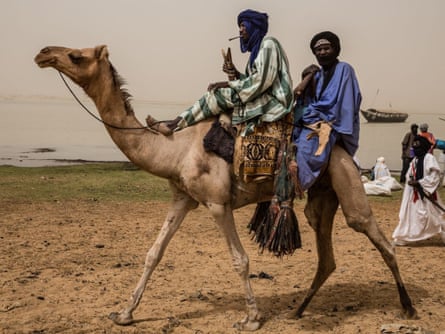
There are other foodstuffs that should not be here: a 20-litre butt of World Food Programme cooking oil costs 12,500 francs. “I am unhappy about that,” says fresh-faced Mohamed Maouloud “Bouna” Sidi Mohamed, who hails from a family dynasty of Arab traders. “By selling aid products, traders are undercutting our oil from Mauritania. I cannot go below 13,500 francs because of my overheads.”
Bouna’s family runs three 10-tonne trucks that travel in a gigantic triangle spanning Algeria, Timbuktu and Mauritania. He admits to transporting fabric, blankets, bootleg Algerian diesel and cigarettes, and the current top-selling Eniem Algerian freezers, sold in Timbuktu for 165,000 francs. Travel is at night – when the sand is hard – and drivers navigate by the stars. They refuel from barrels hidden in the ground. Driving to southern Algeria takes eight days, one-way.
Bouna says the trafficking of African migrants to Europe and the smuggling of South American cocaine is done by “other people”. But the 23-year-old does give details of the “tolls” that must be paid: “It is the wild west here. Corruption is total. Be they armed bandits, mayors, chiefs or uniformed gendarmes, military or customs, everyone gets cash. Mali has no authority over its own territory, so it is unsurprising that others have moved in.”
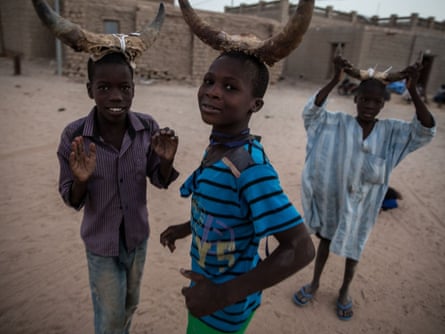
Hallé Ousman, who has been mayor of Timbuktu for eight years, says he gets hardly any help from Bamako. “We survive mainly thanks to a few international donors and four of our twin towns – the famously bookish Hay-on-Wye, Saintes (France), Tempe (Arizona) and Chemnitz (Germany).
“The problem in this country is that we do not trust each other. We need to sit down and talk – all of us: all colours, all people, sedentary and nomadic,” says the 62-year-old.
So why doesn’t he start the process?
“I have tried. But the chaos of northern Mali suits some very influential people. Next to them, I am just a very small mayor.”
Ousman is hoping for a tarred road to Bamako, “to connect us to the south so the people of Timbuktu can consume sugar from Mali”. The plan exists; the European Union has pledged the funds. But it is too dangerous for roadwork to begin. The mayor dreams of tourists too, and the return of the annual music festival which for a decade until 2011 – when a visitor was killed and three more were abducted – provided his city with a home-grown economy.
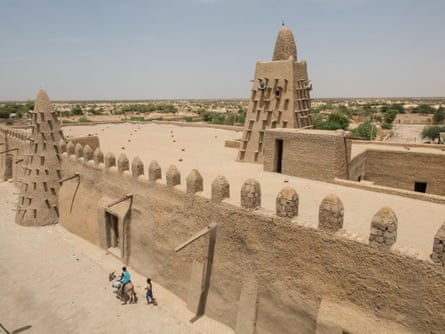
And Timbuktu has a trump card. Its three syllables are capable of inspiring influential people in faraway places. Among our fellow passengers on the UN plane back to Bamako is a team from Google’s Cultural Institute, “host of the world’s treasures online”. They are accompanied by a music impressario and Cynthia Schneider: a former United States diplomat now trotting the globe with her Timbuktu Renaissance Initiative, which seeks to restore the city as “a beacon of tolerance, wisdom and innovation – the signature characteristics of its golden age”.
Timbuktu is disempowered and slowly disappearing. It has suffered the effects of desertification for more than half a century. If ever there was an opportunity to bring back the gold-specked mango trees, it was missed. Instead of a sparkling canal, poor governance and graft run through the veins of this once great city.
The idea of salvation in the form of a Google buggy taking photographs for virtual tours may sound bizarre. But Timbuktu needs to be put back on the map one way or another – or risk finally becoming that mythical place its name has long stood for.






Comments (…)
Sign in or create your Guardian account to join the discussion